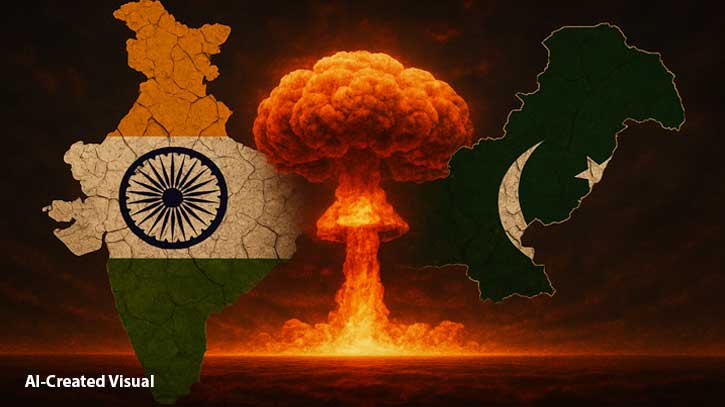One wrong button press could completely alter the reality of the world. Recently, tensions have once again escalated between India and Pakistan. There are rising whispers of a potential war between these two nuclear-armed neighbors. According to U.S. intelligence, a political miscalculation could result in a nearly 20% chance of nuclear conflict between them!
But what if India and Pakistan actually engage in a nuclear war? Who would emerge victorious in such a devastating clash? And would Bangladesh be affected as well?
Imagine a scenario where minor border skirmishes escalate into full-scale warfare. If Pakistan were to launch a nuclear weapon at an Indian military base or a major city, India would likely retaliate with similar force. According to a research paper from Rutgers University, if the two countries together used just 100 nuclear bombs, over 50 million people could die almost instantly. Cities like Delhi, Mumbai, Lahore, Islamabad, and Karachi would vanish from the earth in the blink of an eye. Hospitals, power stations, and water supply systems would be obliterated. Massive mushroom clouds would rise into the sky following the blasts.
For those who survive the initial explosions, the aftermath would be even more horrifying. Survivors would face a grim life of hunger and radiation sickness. Cancer, blindness, severe skin diseases, and neurological disorders would become widespread among the affected populations. Children born after the war would likely suffer from severe birth defects due to radiation exposure. Agricultural lands would become barren, and rivers and water bodies would be contaminated with nuclear waste. A severe drinking water crisis would follow. Human civilization in the region could be set back by centuries. A study from Columbia University states that such a war could throw over two billion people worldwide into a food crisis. Not just India and Pakistan, but also Nepal, Afghanistan, Sri Lanka, and Bangladesh would suffer devastating consequences.
The nuclear explosions would produce “mushroom clouds,” which could rise as high as 70 kilometers into the atmosphere. These clouds would release 5-7 million tons of fine carbon particles into the upper atmosphere, blocking sunlight. As a result, global temperatures could drop by an average of 1.5 degrees Celsius, and this cooling effect might persist for a decade. Seasonal rainfall would decrease significantly, leading to catastrophic reductions in the production of wheat, corn, and rice. Winters would become longer and increasingly unpredictable.
If a nuclear war were to break out between India and Pakistan, Bangladesh would not be spared. Radioactive smoke from the explosions would drift into Bangladeshi skies, turning the air toxic and crippling the nation’s public health system. Long-term effects would include diminished crop yields and the collapse of marine resources in the Bay of Bengal due to climate disruptions. Moreover, the chaos inside India could trigger mass migrations, with millions attempting to cross into Bangladesh, causing immense humanitarian and economic strain.
Although such a catastrophe has not yet occurred, it is far from a mere fantasy—it is a scientifically modeled and intelligence-supported possibility. Should such a war begin, humanity would enter one of its darkest chapters, one from which recovery might be impossible. In such a scenario, there would be no true victors—only mutual destruction.

